Digital experience platforms (DXPs), considered an improved version of headless CMSs, are gaining traction with enterprises. According to IBM’s report, 26% of organizations that invested in digital customer experience adopted a DXP.
But the question is, which DXP works best with the ecommerce stack? Our team analyzed the most popular vendors and made a shortlist of retail-oriented DXPs. Each review discusses key offerings, strong sides, and potential constraints. As a cherry on top, we added insights into how each DXP integrates with BigCommerce — an open SaaS ecommerce platform.
What is a Digital Experience Platform?
A digital experience platform (DXP) is a cloud-based software for creating, managing, optimizing, and personalizing digital experiences across channels and touchpoints.
DXP vendors combine marketing, sales, and editorial workflow automation functionalities, ranging from page builders and content management tools to AI-powered recommendations and conversion rate optimization apps. By design, DXPs are extendable. You can integrate them with other systems in your stack using available APIs, SDKs, and premade connectors.
An efficient digital experience platform helps:
- Build efficient content production workflows
- Distribute content assets across multiple channels
- Deliver and personalize content across touchpoints
- Optimize content performance and conversion rates
- Aggregate and analyze customer engagement data
- Establish unified customer profiles and content personas
- Manage and reuse marketing assets (images, videos, etc.)
In addition, many DXPs also offer tools for social media management, AI-driven content creation, customer relationship management, and more. Since a DXP provides a collection of tools and has flexible licensing, it’s highly adaptable for different use cases and industries.
You can use all out-of-the-box features or select specific capabilities. Many platforms offer unbundled pricing for different products (e.g., headless CMS, content marketing platforms, digital asset management systems, etc.).
Overall, DXP adopters name the ability to create real-time customer engagement, 360-degree customer profiles, and enhanced customer service as the main advantages of using a DXP.
The Most Valued Digital Experience Platform Benefits
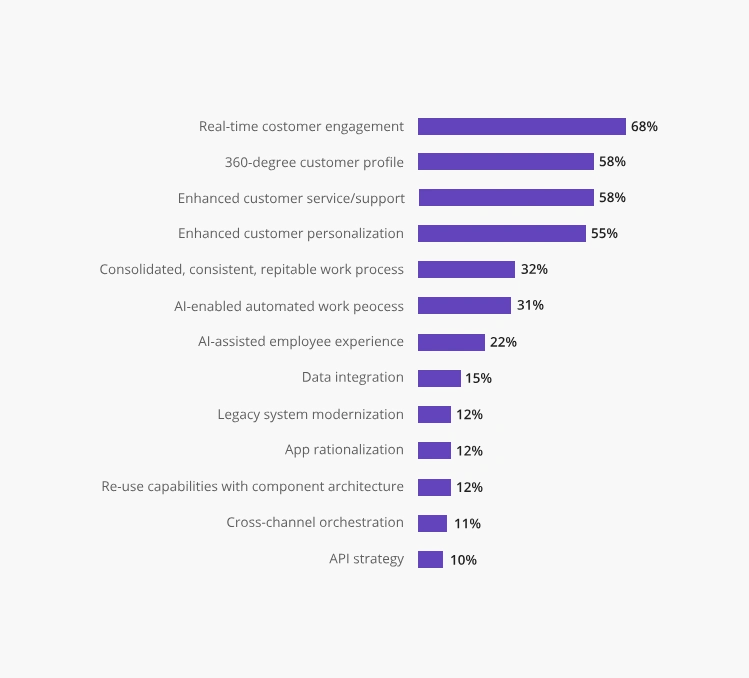
Source: IBM: Unleash Your Platform’s Power
Examples of the Best Digital Experience Platforms for Ecommerce
Surely, the best DXP is the one that can help you solve your business challenges, fits your team’s needs, and can scale in line with your ambitions. However, there are leaders in the industry whose technology is more mature and scalable.
To create the list of the best digital experience platforms, we have referred to Gartner’s Magic Quadrant Report. We’ve selected vendors from the Leaders category and the Visionary category.
Optimizely
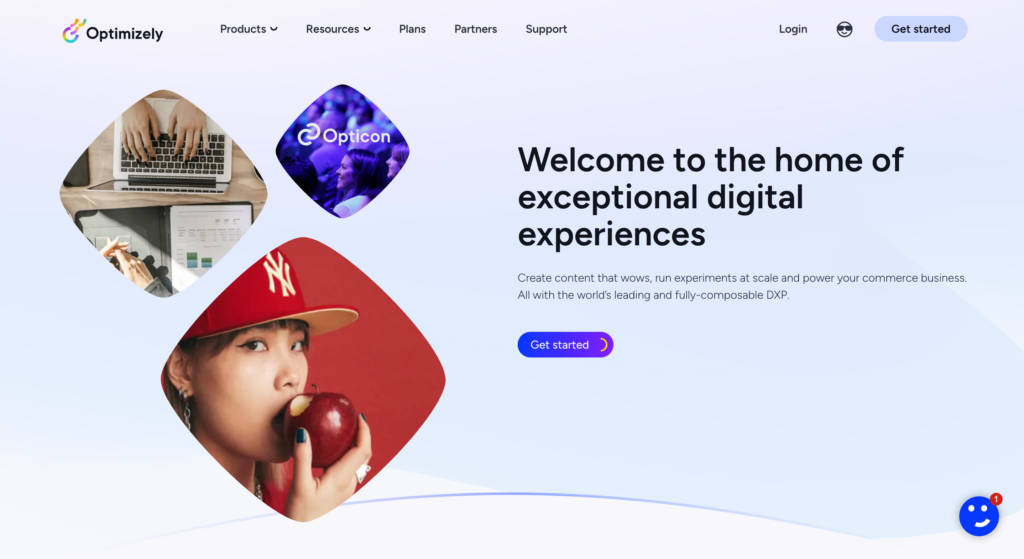
Optimizely is a hybrid DXP with three integrated products:
- An Orchestrate suite features a headless CMS, a content marketing platform (CMP), and several more content production and management tools.
- An Experiment suite includes advanced conversion optimization tools and a robust content personalization engine.
- A Monetize suite helps retailers with shopping experience optimization, product recommendations, and individualized search results.
A headless CMS hooks you up with all the tools you need for content development, asset management, localization, and personalization. Optimizely CMP provides a convenient workspace for campaign management. Benefit from an in-built task & workflow management for marketing campaigns, managing dependencies, and work requests. Level up your campaign execution with native tools for performance management. CMP also offers a marketplace, allowing you to search for images and licensed content in the system.
According to Forrester, adopting Optimizely results in 360% ROI and a 60% increase in conversion rate. Some advantages include better website performance, license fee savings, reduced integration maintenance time, and streamlined content deployment.
Optimizely Reviews
Optimizely’s extensive A/B testing has won the hearts and minds of large retailers on Gartner. Meanwhile, reviewers from G2 have praised the easy transition between different Optimizely product features, scenario-based campaign creation, seamless reporting dashboards, and accurate product recommendations.
However, one merchant experienced a lack of monitoring for deployed experiments. Also, a Content Marketing Specialist complained about custom modules lacking a WYSIWYG editor that native modules have.
Select Retail Clients: Canon, Missguided, eBay
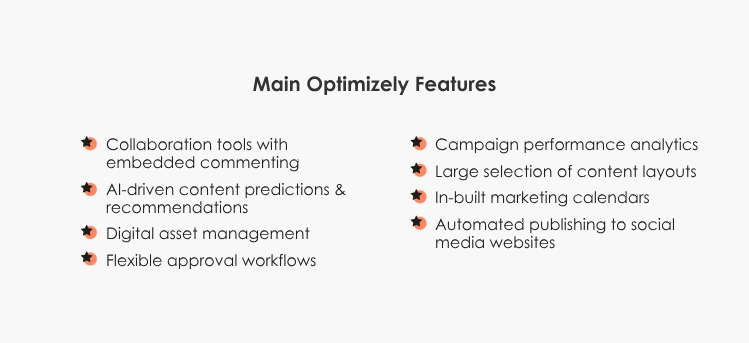
Extensions and Integrations
Optimizely’s marketplace has two types of premade connectors: free and paid. There is no pre-configured connector between Optimizely and BigCommerce. So, to create a custom integration, you need to contact a BigCommerce-certified development partner like Edvantis.
To build custom integrations, use CMP Open REST API. To add custom integrations to CMS, utilize Content Management API, Content Delivery API, Community API, and others.
Adobe Experience Manager (AEM)
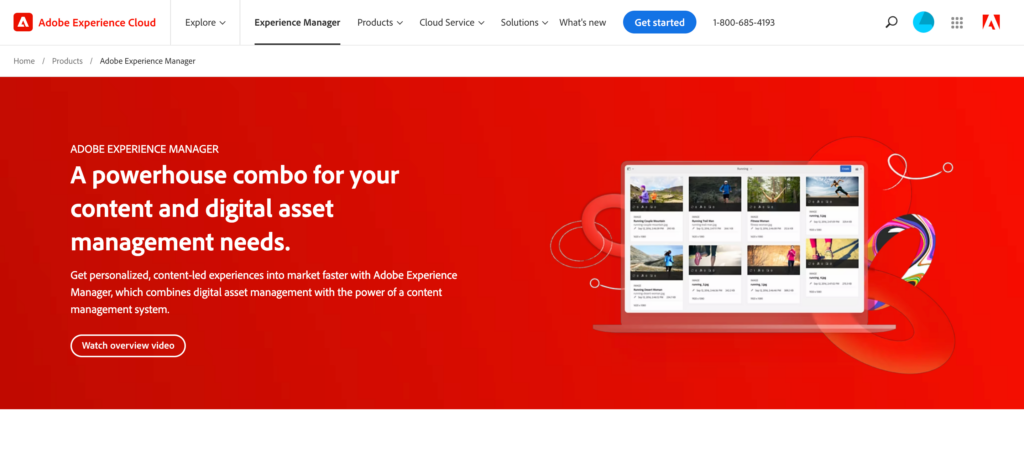
Adobe Experience Manager combines a headless CMS (called “Sites”) with a digital asset management system (called “Assets”), enabling composable content management and personalization.
“Sites” provides users with an AI-powered tool for writing, editing, personalizing, and experimenting with content tailored to different customer segments, markets, and channels. The CMS also offers customizable design layouts you can customize with Adobe’s premade development tools.
“Assets” provides a scalable, secure solution for all your marketing collateral, designed for easy collaboration. Besides standard asset types, Adobe also supports 3D images and VR videos. Moreover, users get generative AI tools for content creation and editing. With Assets, you can create content in multiple formats, sizes, and languages — and then dynamically deploy them to deliver beautifully personalized customer experiences.
Adobe Experience Manager Reviews
Reviewers on Gartner have been satisfied with the content loading time for AEM-hosted pages/assets and the high degree of content customization. They praised the system’s extensive reporting capabilities, strong data governance, and advanced content reusability across owned channels and third-party touchpoints.
One enterprise adopter noted how AEM tools for content creation, asset sharing, and multichannel publishing boosted their team productivity. However, reviewers on Trustradius commented that AEM has a steep learning curve, which results in long training and onboarding.
Select Retail Clients: Under Armour, DICK’S Sporting Goods, Casio
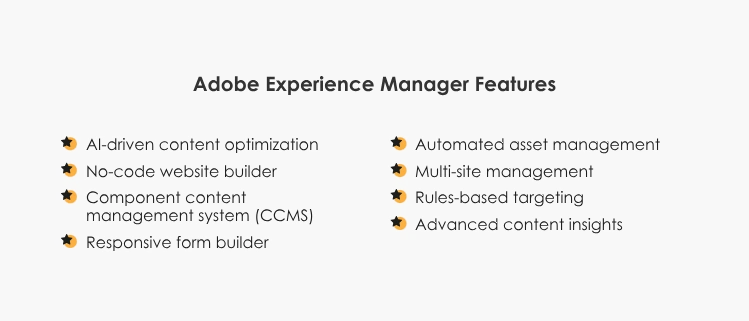
Extensions and Integrations
Adobe Experience Manager has pre-built connectors with Cludo, Algolia Search, Wezen, and Enautics. BigCommerce offers a premade connector with Adobe Experience Manager. The integration syncs catalog, user, and product data and provides PCI-compliant checkout.
You can extend Adobe Experience Manager capabilities further with third-party integrations. Also, you can build custom apps with Adobe’s App Builder and run them on Adobe infrastructure.
Acquia
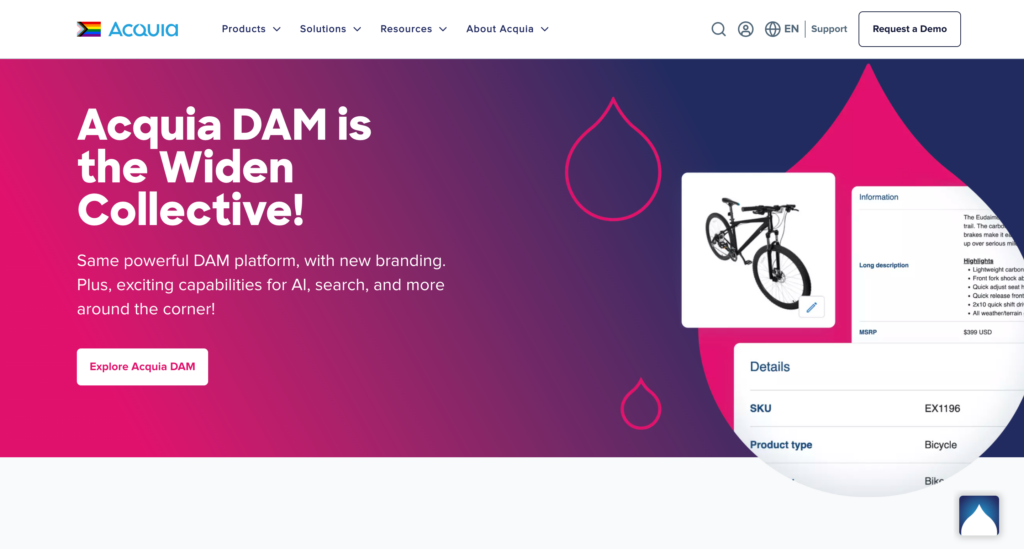
Acquia is a hybrid DXP based on Drupal, combining the benefits of a large open-source community and an API-driven extensibility of headless architecture.
There are six core components of Acquia DXP:
- Drupal-based CMS offers low-code tools to manage, reuse, and cross-publish content.
- The managed cloud platform can host all the deployed solutions and customer experiences.
- The site factory is an integrated development environment for creating and deploying multiple websites.
- A customer data platform (CDP) provides data analytics, governance, and integration with other marketing solutions.
- Campaign Studio is helpful for centralized campaign management across channels and markets.
- Digital asset management (DAM) is a secure, scalable repository for all marketing assets you have.
The most relevant products for ecommerce companies are Campaign Studio, DAM, and CMS.
Acquia’s Campaign Studio allows marketers to analyze how customers behave across different channels. It also offers convenient tools for data-driven content development and marketing campaign planning. Build visual journey maps based on real-time data to identify the most promising touchpoints and optimize brand interactions. Another handy feature is an in-built if/then customizable algorithm for automating processes across customer journeys.
Acquia’s DAM conveniently organizes all your digital assets to reuse for content creation, marketing campaigns, emails, and page building. You can easily find, approve, publish, and keep track of an array of assets. There’s also an in-built converter for repurposing content.
Acquia’s CMS is an excellent upgrade from a traditional Drupal CMS. You get a mix of no-code, low-code, and high-code extension capabilities. Enterprises can also benefit from a starter low-code kit for creating a proof-of-concept CMS. Marketers enjoy automated SEO processes, customizable dashboards, and streamlined content localization for over 100 languages.
Acquia Reviews
Enterprises on Gartner praise Acquia for its streamlined marketing automation, easy content curation, intuitive customer journey mapping, and seamless omnichannel personalization capabilities. One client especially liked the open-source nature of Acquia. The active community behind the solution helps development teams speed up the implementation process and expand the CMS native features.
That said, the biggest constraint of Acquia is that it only supports Drupal projects. If that’s not your preferred CMS, consider another option.
Select Retail Clients: KitKat, Seventh Generation, Crayola
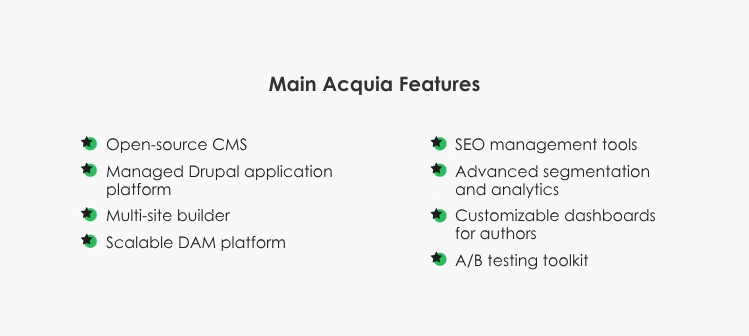
Extensions and Integrations
Acquia has official pre-configured integrations with Oracle Bronto, IBM Silverpop, Monetate, AWS, Google Cloud, and Responsys. Since Drupal is open-source, there are over 10,000+ community-created extensions and integrations.
There’s no official premade connector between the BigCommerce platform and Acquia. Therefore, you will need a development partner for the task.
Sitecore
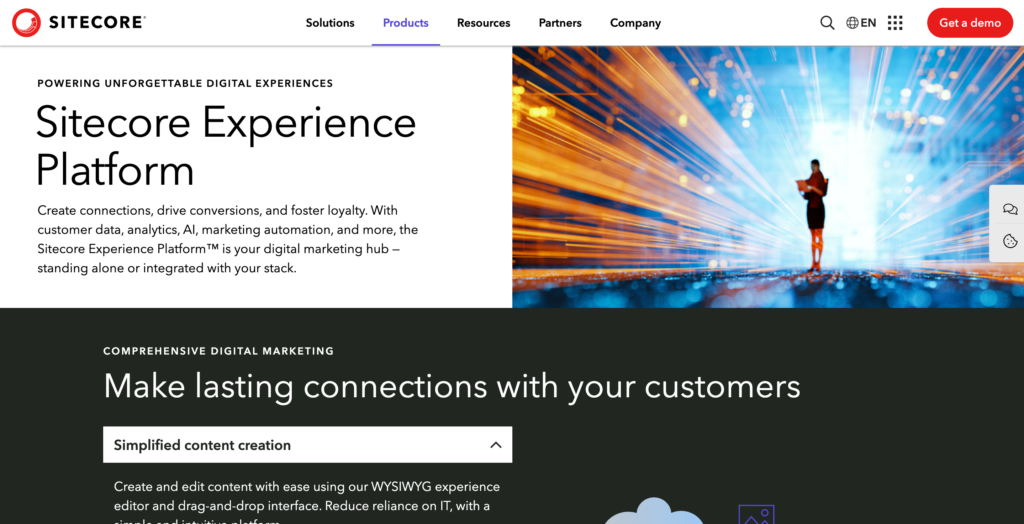
Sitecore provides a Platform DXP with an integrated CMS and customer data, analytics, and marketing automation capabilities. You can host its DXP both on the cloud and on-premises.
The Platform DXP consists of three components:
- Sitecore Experience Manager (XM) is a CMS with advanced content production and personalization features.
- Sitecore Experience Platform (XP) offers customer data management features, a marketing automation toolkit, and AI-driven analytics.
- Managed Cloud is an optimized cloud service for hosting all Sitecore-based applications.
Sitecore XM enables you to manage your content across multiple channels and adapt it to various markets with extensive localization capabilities. You can reduce your dependence on Software Developers with low-code UX templates, pre-built page components, and a drag-and-drop builder.
Sitecore XP can become the one-stop shop for all your marketing needs. The solution offers an advanced customer profile builder where you can add all customer interactions, behaviors, and habits. Then, you can make sense of the collected information with an ML-based analytics engine. Share insights with your teams via customizable graphs and dashboards. Use first-hand customer intel to create personalized content and then split-test it across user segments and channels.
To streamline website building and customization, Sitecore has an Experience Accelerator. It allows marketing teams to create new pages using no-code tools, reusable renderings, pre-built themes, and grid systems.
Sitecore Reviews
One enterprise merchant on Gartner particularly liked Sitecore’s A/B testing toolkit and customer behavior analytics. Other retail adopters have positively reviewed Sitecore’s content design tools, customer engagement analytics, and extensive personalization capabilities.
However, reviewers from G2 talk about Sitecore’s lengthy implementation process, complex upgrading, and steep learning curve. One enterprise adopter from Trustradius also noted that implementation was time-consuming, costly, and required much developement work.
Select Retail Clients: Subway, MarineMax, UK SME
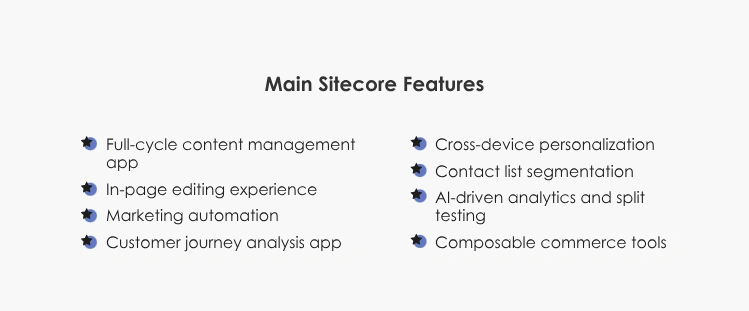
Extensions and Integrations
Sitecore Experience Manager has native connectors with Salesforce Marketing Cloud, RelevantEdge, Smartling, LanguageWire, and CognityAI. Sitecore’s fully API-driven architecture also allows for building multiple custom integrations using technologies like React, Node.js, Gatsby, and Netlify. There is also a “BigCommerce for Sitecore” integration that connects product data with a DXP.
Bloomreach
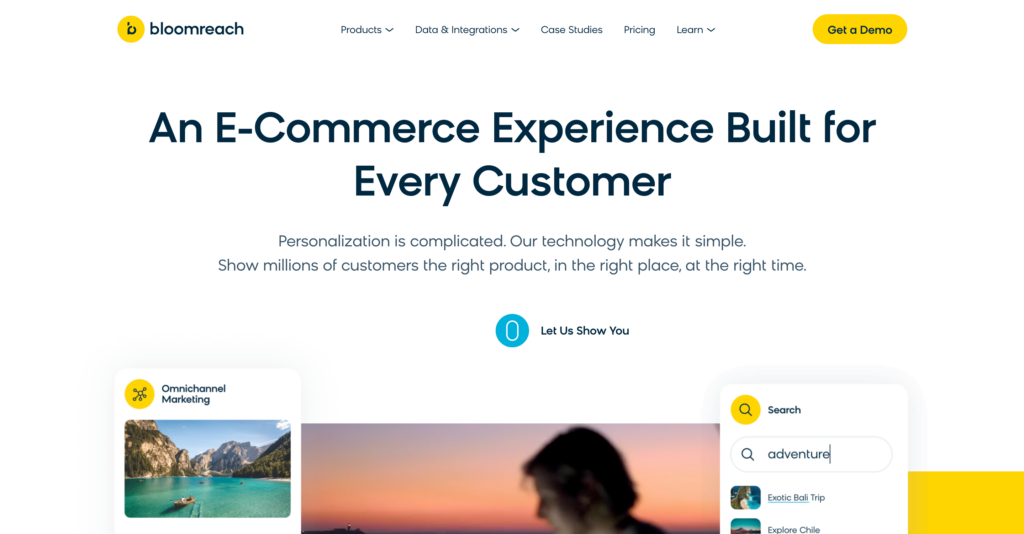
Bloomreach is a composable DXP with a strong focus on commerce and merchandising. Its strong suit is extensibility. You can customize and scale the DXP through premade integrations or custom integrations.
Bloomreach DXP includes three sub-products:
- Engagement enables you to shape your communication with customers and streamline marketing campaigns. Create and reuse campaigns across channels and personalize them to different user segments. Plus, collect detailed analytics from each touchpoint.
- Discovery has everything you need to optimize on-site customer experiences, including product recommendations, personalized search results, and convenient category ranking.
- Content is a headless CMS that allows your teams to build pages with drag-and-drop tools, create and reuse content across different channels, and do split tests.
In addition, Bloomreach offers a data engine – a solution that enables gathering and visualizing information about customer interactions and behaviors across all touchpoints. Based on the collected information, you can segment your customers per location, age, or other custom criteria and contextualize your marketing and content strategy. What’s more, Bloomreach CDP offers advanced AI-driven tools to predict your customer’s actions and preferences.
Bloomreach Reviews
Enterprise merchants on Gartner praised Bloomreache’s on-site search results personalization, a good selection of available integrations, and convenient marketing automation tools. Trustradius reviews highlight the platform’s omnichannel behavior tracking tools, contextualized product recommendations, and automated SEO capabilities.
However, one adopter in retail says Bloomreach’s A/B testing needs to be more mature (unlike their other features). Another one points to relatively weak analytics capabilities.
Select Retail Clients: Yves Rocher, Rapha Racing, Alshaya Group
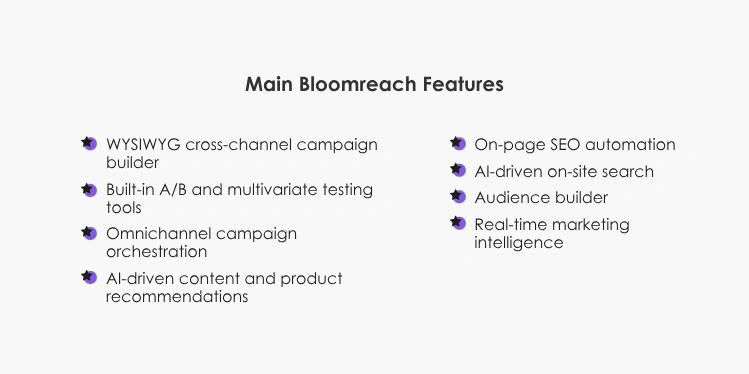
Extensions and Integrations
Bloomreach’s pre-built connectors are SAP Commerce Cloud, Salesforce B2C Commerce, BigCommerce, Amazon, and DocuSign. This DXP is API-first so that you can integrate any third-party or custom app. Bloomreach provides some APIs and SDKs. For instance, Engagement has Mobile SDK, Java SDK, Python SDK, and Engagement API. The Content app offers Delivery and Management APIs. And Discovery has Bloomreach Discovery SDK and an array of Search, Catalog Management, and SEO APIs.
There is a premade connector with Bloomreach Engagement and Discovery products on the BigCommerce marketplace. To integrate the platform with the Bloomreach Content, contact the DXP sales or hire a third-party development vendor.
Our Methodology
We used Gartner’s Magic Quadrant to create our list of best DXPs. In addition, we analyzed the voice of customer data from Gartner, TrustRadius, and G2 to form objective opinions about the strengths and downsides of each platform.
On Gartner, we analyzed feedback from organizations with 1B-10B and 10B+ in revenue from the Retail and Consumer Goods industry. On TrustRadius and G2, we have selected reviews from enterprise-sized companies, focusing on Retail and Consumer Goods adopters whenever possible. Where available, we also used information from Forrester Economic Impact Studies.
Getting Started with a New DXP
Once you’ve selected the right DXP, the next step is its configuration and deployment. That’s another complex journey because:
- DXPs require integrations with multiple other retail systems (e.g., an ecommerce platform, 3PL system, CRM, ERP, etc.)
- Poor (or non-existent) data governance processes can stand in the way of value generation (i.e., siloed data or unsuitable data formats prevent DXP adopters from using advanced analytics capabilities).
- Siloed internal workflows also make DXP adoption an uphill battle.
Edvantis can help you architect the optimal DXP deployment and facilitate integrations. As a BigCommerce-certified partner, we help retailers adopt headless architectures and establish scalable, secure data management, governance, and analytics processes. Contact Us!
FAQ about Digital Experience Platforms
DXP is software for building, managing, delivering, and personalizing digital experiences across channels. DXP includes a set of integrated solutions like CMS, DAM, CRM, analytics tools, commerce engine, etc. DXP is complex and has more capabilities by default. However, DXP is more expensive and takes longer to implement and set up. CMS, on the other hand, is an application designed exclusively for content management. CMS is lightweight and costs less. But you will need to invest development time for integrations and customizations.
DXP caters to brands who need to contextualize their content, deliver seamless customer experience across multiple channels, step up their asset management efforts, and automate marketing operations. But DXPs are typically expensive and complex to implement – therefore, enterprise-sized businesses are their primary target audience. However, many DXPs enable using their separate offerings rather than the entire integrated set. So, you can start small (for instance, with CMS) and add new tools (like DAM or DMP) as you grow.
To select a digital experience platform, outline the customer demands you seek to meet and analyze the needs of your marketing and development team. Based on that information, compile a list of nice-to-have tools and integrations. Then, check how well the potential DXP delivers and maintains your required functionalities. For instance, read feedback from their past customers or schedule demo calls.
Look for a DXP with the features & integrations you need: real-time customer engagement, marketing automation, asset management, SEO optimization, AI-driven process automation, etc. But remember: too many unnecessary tools may overwhelm your teams, prolong implementation, and impede loading speeds. Generally, check how DXP integrates with other apps. See what security measures and regulatory restrictions it has. Read about the quality of their documentation and customer support. And finally, look for a DXP that’s affordable for you to maintain in the long run.


